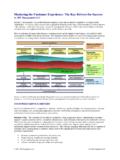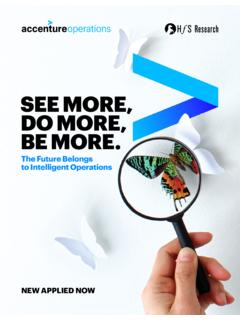Transcription of Rewarding and Incenting Customer Service …
1 Rewarding and Incenting Customer Service Representatives A guide to help you keep your Customer Service teams happy and providing consistently high quality Service By Craig Bailey President Customer Centricity, Inc. Rewarding and Incenting Customer Service Representatives Introduction Effectively Rewarding and Incenting Customer Service representatives can be complex. The types of incentives and rewards are important to consider, but certain prerequisites must be in place to ensure that your rewards and incentive program is truly effective. To be comprehensive, this series will cover the following topics: Be careful what you ask for Empower the front-line personnel Align the rest of the organization Provide immediate recognition Financial incentives Be Careful What You Ask For Said differently - you get the behavior that you measure and reinforce. This became glaringly clear to me during an experience I had upon inheriting a Customer Service organization.
2 As I began the process of coming up-to-speed on the inner-workings of the organization, its personnel, processes, levels of performance and customers, I discovered that we were primarily focused on production metrics, such as: Average speed to answer, call wait time, abandonment rate, etc. To reinforce this set of performance metrics, our employees' quarterly bonuses were tied to the achievement of goals in this area. We were performing fairly well against the goals that had been established. However, when I spoke with customers I realized the effect that this "production focus" was having on Customer satisfaction. That is, the customers could tell that our Customer Service organization was focused on processing calls as quickly as possible, and that "resolving my Service issue or question is secondary to efficient call processing." We were getting precisely the behavior we were Rewarding , just not the behavior we wanted.
3 To be clear, production metrics are important barometers to monitor in managing a Customer Service organization. If your organization focuses on production metrics as the "primary" performance indicator, you will get what you asked for. That is, you will perform highly "efficient" transactions with customers. However, you will NOT generate "effective" relationships with your customers. In fact, the Customer will KNOW that you are trying to get them off the phone as quickly as possible, to take that "next call." The reality is that you want to ensure that each Customer feels that they are the most important call that your company is taking (at that time). Metrics to consider for ensuring that focus isn't merely on production include: number of repeat calls (for the same issue, by the same Customer ); first-touch resolution; and, most importantly, Customer satisfaction.
4 At my company, after we realized that we were focused on production metrics rather than the Customer relationship or satisfaction levels of our Customer -base, we decided that it was time for a change. While we continued to watch the traditional call center metrics, we changed our bonus program to be focused on Customer satisfaction. And, guess what quarter-over-quarter Customer satisfaction continued to climb! And, the company was subsequently rewarded for this by being acknowledged as #1 in Customer Service , for their industry. Empower the Front-Line Is your front-line restricted from providing exceptional levels of Customer Service by rigid procedures and micro-management? Not only can this be the MOST frustrating thing that a Customer Service representative faces, it also has a negative impact on your ability to motivate your Customer Service representatives.
5 They really WANT to do the right thing, but don't want to get hand-slapped for deviating from procedure. While procedures and guidelines are absolutely critical to ensure a smoothly operating Customer Service function, it is important to remember that your employees are intelligent human beings with common sense and good judgment. Copyright 2004 Customer Centricity, Inc. All Rights Reserved Like any normal Customer , I suspect that you have experienced situations similar to the following: Example 1: You are discussing an issue with a Customer Service representative that would, at the end of the day, cost the firm less to resolve than the cost of the call. However, because the Customer Service person is bound by rigid procedures, she is required to explain, and explain again, why she cannot take remedial action because it is not standard operating procedure. For those of us that are aggressive, what do we do next?
6 We politely ask "may I speak with your supervisor?" Cha- ching. Did you just hear more cash leave your coffers? Example 2: You are at a retail establishment that sells high-end pens. The Customer (me) sees a very nice pen in the display case that he'd like to purchase. However, much to his dismay, he learns that the only one left is in the display case. He asks the Customer Service person "may I buy the one in the display case?" You know the response So, instead, I end up buying a pen that was half the price. To achieve an empowered, yet consistent, workforce, you must strike a balance between rigid procedures and individual judgment. You should manage your Customer Service function with well- defined procedures, yet make it clear that where there are opportunities to "do the right thing for the Customer " within certain guidelines, the Customer Service representatives should do so.
7 After the "transaction" has completed, a discussion can take place, if necessary, to refine the guidelines so that others can provide a similar response if the situation comes up again. And, if it was the wrong decision, which invariably will happen from time to time, then management should diplomatically explain the impact of this decision to avoid it recurring in the future. However, this should NOT be done in a reprimanding fashion. The only time that a reprimand is appropriate is when a Customer Service representative has demonstrated repeatedly (3 times, at a minimum) his or her lack of common sense and good judgment. By effectively empowering your Customer Service representatives to do the "right thing" for the Customer , even when it deviates from defined procedures, you will find that employee satisfaction will go up. This occurs because the Customer Service representatives feel trusted by management to do the right thing for the Customer , which is what they REALLY want to do.
8 As you can imagine, this will also have a positive impact on Customer satisfaction, retention and finally operational efficiencies. Align the Rest of the Organization A common goal of many Customer Service organizations is to resolve each Customer 's inquiry on the "first touch," without the front-line having to hand the Customer off to other parts of the organization. However, Customer satisfaction and retention do not rest solely on Customer Service . The front-line maintains a critical dependency on the "rest of the organization" to effectively Service and support the Customer base. Organizational dependencies key to achieving high levels of Customer satisfaction and retention include: Product Management Ensuring that products and services are released only when they are ready, and Customer Service personnel provide input and receive training on new products and services in advance of market availability.
9 Sales and Marketing Ensuring that expectations are properly set regarding the capabilities, delivery, implementation timeframe and/or performance of the products and services . By doing this, the Service organization can effectively meet or exceed these expectations. Have you heard the phrase "under promise and over perform?" Too often, the Service organization is placed in the opposite position. That is, something was "over promised" which results in the Customer Service organization attempting to recover from the situation where the firm is "under performing" to the customers' expectations. Technical Support Ensuring a timely response to, and resolution of, Customer issues that require a higher level skill set, based on predefined guidelines and priorities. Additionally, ensuring that there is an effective process in place to perform scheduling, planning and Copyright 2004 Customer Centricity, Inc.
10 All Rights Reserved notification of upgrades / maintenance activities to minimize / eliminate unanticipated impact to the Customer -base. Finally, to continuously push capabilities to the front-line to increase "first-touch resolution.". Engineering Ensuring a timely response to bugs and enhancement requests. This includes providing Customer Service with a specific timeframe for response, based on predefined guidelines and priorities. The response could include a "commit date" for resolution or an indication that the item will not be addressed at all, and why. This ensures that Customer Service is not "stuck in the middle" without the ability to set Customer expectations. (See the article "Bug Fix Promises?" in issue #32 of our newsletter for more information related to the topic of managing bug reports.). Senior Management Ensuring their awareness of, and engagement in, responding to trends that are impacting Customer Service , satisfaction and retention, by allocating resources to invest in their prevention and/or resolution.




